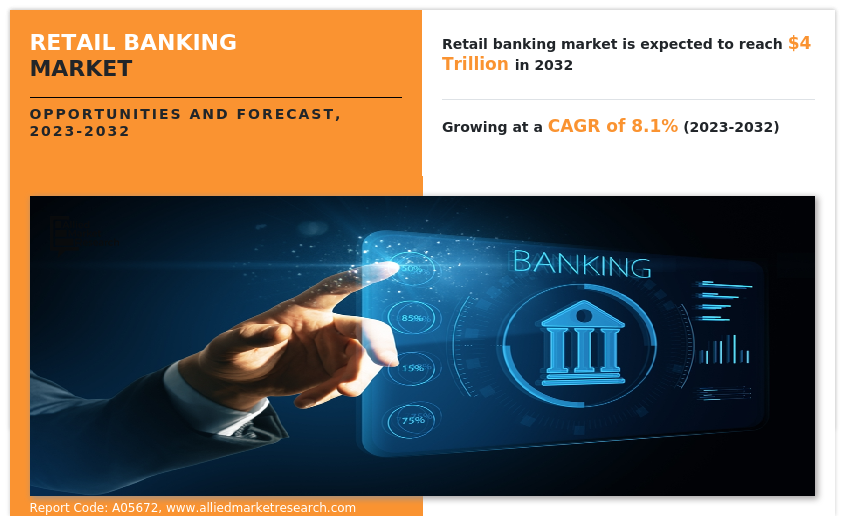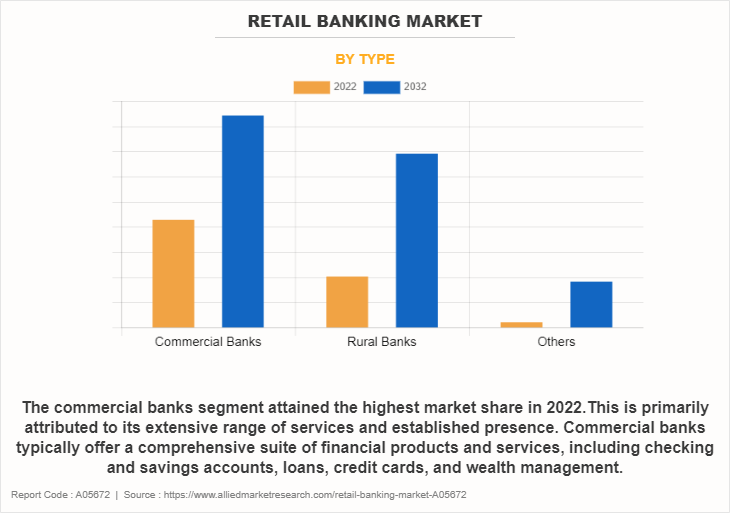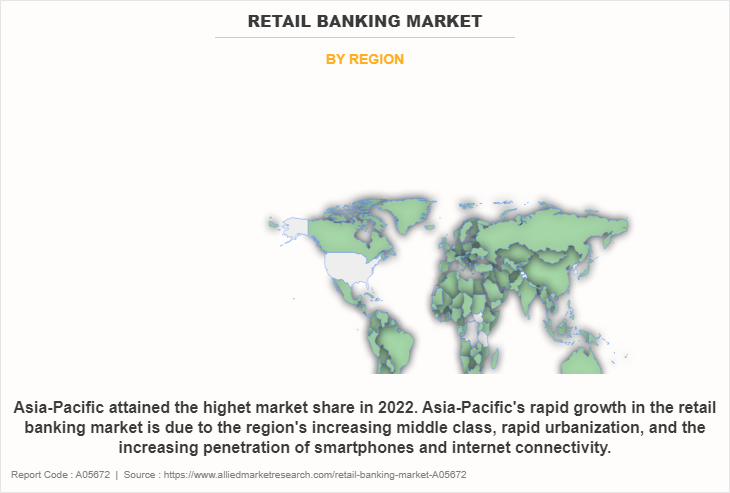Retail Banking Market Overview
The global retail banking market was valued at $1.9 trillion in 2022, and is projected to reach $4 trillion by 2032, growing at a CAGR of 8.1% from 2023 to 2032. Advanced technology and digital solutions enhancing customer experience, streamlining operations, and expanding access through innovations such as mobile apps, AI tools, and personalized online services are contributing to the growth of the market.
Market Dynamics & Insights
- The retail banking industry in Asia-Pacific held the largest share of 34% in 2022.
- By type, the commercial banks segment dominated the market, accounting for the revenue share of 56% in 2022.
- By function, the bank account opening segment dominated the market, accounting for the revenue share of 35% in 2022.
- By end user, the individual segment held the largest share in the market, accounting for the revenue share of 67% in 2022.
Market Size & Future Outlook
- 2022 Market Size: $1,900 Billion
- 2032 Projected Market Size: $4030.3 Billion
- CAGR (2023-2032): 8.1%
- Asia-Pacific: dominated the market in 2022
- LAMEA: Fastest growing market
What is Meant by Retail Banking
A retail bank is a financial institution that primarily serves individual consumers and businesses. Its core functions revolve around providing basic financial services, such as accepting deposits, granting loans, and facilitating everyday transactions such as checking and savings accounts. Retail banks are the most familiar face of the banking industry to the general public, with numerous physical branches, ATMs, and an online presence. They offer a range of products and services tailored to meet the financial needs of individuals, including personal loans, mortgages, credit cards, and investment opportunities. In addition, they often provide services such as wealth management, retirement planning, and insurance products. The key distinction of a retail bank lies in its focus on serving individual customers rather than large corporations or institutions, making it a vital component of the broader financial ecosystem for everyday people seeking access to essential financial tools and services.

The retail banking market is propelled by rapid technological advancements and the embrace of digital transformation revolutionizing customer interactions and reducing operational costs through innovations like mobile banking and AI-driven services. In addition, changing customer expectations and demand for personalized experiences are pushing banks to invest in user-friendly interfaces and omnichannel strategies. Furthermore, regulatory shifts and compliance focus foster trust and mitigate risks for institutions committed to meeting evolving regulatory standards. Therefore, these are the major driving factors in the retail banking market.
However, the industry faces intense competition from agile fintech startups and economic uncertainty with persistently low interest rates, challenging profitability, and stability, which is hampering the market growth. However, availability of data presents a promising opportunity for the retail banking market. By harnessing advanced analytics and AI, retail banks can offer highly personalized financial solutions, enhancing customer satisfaction, identifying trends, and driving revenue growth through innovative products and services tailored to specific segments.
The report focuses on growth prospects, restraints, and trends of the retail banking market analysis. The study provides Porter’s five forces analysis to understand the impact of various factors, such as bargaining power of suppliers, competitive intensity of competitors, threat of new entrants, threat of substitutes, and bargaining power of buyers, on the retail banking market.
Retail Banking Market Segment Review
The retail banking market outlook is segmented on the basis of type, function, end user, and region. On the basis of type, the market is bifurcated into commercial banks, rural banks, and others. Based on function, the retail banking industry is bifurcated into bank account opening, deposits and withdrawals, debit and credit card issuance, investment and insurance, and others. Based on end user, it is divided into individuals and businesses. On the basis of region, it is analyzed across North America, Europe, Asia-Pacific, and LAMEA.

By type, the commercial banks segment attained the highest market share in the retail banking industry. This is primarily attributed to its extensive range of services and established presence. Commercial banks typically offer a comprehensive suite of financial products and services, including checking and savings accounts, loans, credit cards, and wealth management. Moreover, they often have a vast network of branches and ATMs, providing easy accessibility to customers. This familiarity and accessibility instills a sense of trust and confidence in consumers, making commercial banks the go-to choice for their diverse financial needs.
However, the rural banks segment is attributed to be the fastest-growing segment during the forecast period in teh retail banking market share. This is attributed to its strategic focus on underserved areas and specialized services tailored to the unique needs of rural communities. Rural banks are adept at understanding the specific challenges and financial requirements of rural populations, which can differ significantly from urban areas. By offering services like agricultural loans, microfinance, and community-based financial solutions, rural banks address critical gaps in financial inclusion, thereby attracting a previously untapped customer base. In addition, government initiatives and policies aimed at boosting financial access in rural areas further fuel the growth of this segment, making rural banks a promising area for expansion and innovation within the retail banking market.

Region-wise, Asia-Pacific attained the highest growth in 2022 in the retail banking market size, owing to the region's increasing middle class, rapid urbanization, and the increasing penetration of smartphones and internet connectivity. As more individuals gain access to digital platforms, there is a growing demand for convenient and accessible banking services. Moreover, many countries in Asia-Pacific have traditionally been savings-oriented, providing a strong foundation for retail banking services. The dynamic nature of emerging markets in this region, along with rise in trend in consumer spending, presents opportunities for retail banking to expand its footprint. Moreover, the untapped potential of a vast customer base, combined with the adoption of cutting-edge technology, positions Asia-Pacific for the future growth of the retail banking market growth.
The report analyzes the profiles of key players operating in the retail banking market such as Barclays, BNP Paribas, Citigroup, Inc., Deutsche Bank, Goldman Sachs, Industrial and Commercial Bank of China ( Asia ) Limited., JP Morgan Chase & Co., Mitsubishi UFJ Financial Group, Inc., The Hongkong and Shanghai Banking Corporation Limited, and Wells Fargo. These players have adopted various strategies to increase their market penetration and strengthen their position in the retail banking market.
Competition Analysis
What are the Recent Partnerships in the Retail Banking Market
On March 27, 2023, IDFC First Bank partnered with Swedish company Crunchfish to pilot a project to demonstrate offline retail payments. IDFC First Bank, is set to be a part of RBI's pilot project to enable offline payments. The project will give access to digital payments even when there is no network. The unique digital payment solution was designed by Crunchfish for merchants and customers under the RBI's Regulatory Sandbox Program. This project will provide support for offline retail payments based on a Digital Cash platform to the payment ecosystem of India. IDFC FIRST Bank will be one of the first few banks to be a part of this pilot project by HDFC Bank.
What ae the Recent Product Launches in the Retail banking Market
On August 23, 2023, Citi’s U.S. Retail Bank introduces simplified banking, a more straightforward way of banking. By retiring account packages and introducing Relationship Tiers, Citi is streamlining its benefits and services and enhancing the customer experience. New customers can benefit from these changes immediately and Citi will begin converting existing customers to simplified banking in 2024. These latest changes are designed to create a more seamless experience for our customers and make it easier for them to get personalized advice and access their finances.
What are the Top Impacting Factors in Retail Banking Industry
Technological Advancements and Digital Transformation
The rapid evolution of technology is a significant driver for the retail banking market. Innovations such as mobile banking apps, online platforms, and advanced analytics have revolutionized customer interactions and streamlined operations. This has not only enhanced convenience for customers but also reduced operational costs for banks. The integration of artificial intelligence and machine learning further enables personalized services, fraud detection, and improved decision-making, offering a competitive edge to banks that embrace these technologies. In addition, as customers are adopting digitalization, retail banking landscape has become easier to access from the comfort of their homes. Thus, the technological advancements and digital transformation in the retail banking sector is a major driving factor for the growth of the market.
Intense Competition from Fintech Startups
The rise of fintech startups has intensified competition in the retail banking sector. These agile, tech-savvy companies often offer innovative, niche-focused solutions that can challenge traditional banks. Moreover, FinTech’s offer discounts and gifts to their customer for using their services which the retail bank most often do not. Also, the younger generation is attracted to these online Fintech apps for their banking related services which is easy to understand rather than the brick and mortar based traditional banking offered by the retail banking business. To counter this, established retail banks must invest in technology, partnerships, or even consider acquisitions to stay competitive and continue to meet the evolving needs of their customer base.
Personalized Financial Services and Data-driven Insights
The huge amount of data available to retail banks presents a significant opportunity. By utilizing advanced analytics and artificial intelligence, banks can offer highly personalized financial advice and solutions to their customers. This not only enhances customer satisfaction but also enables cross-selling opportunities. In addition, utilizing data-driven insights can help banks identify trends, manage risks, and create innovative products and services that cater to specific customer segments, ultimately driving revenue growth and market differentiation. Therefore, the availability of data with the retail banks will provide numerous opportunities for the retail banking sector to offer personalized services to their customers by utilizing technology in the upcoming years.
What are the Key Benefits for Stakeholders
- This report provides a quantitative analysis of the market segments, current trends, estimations, and dynamics of the retail banking market forecast from 2023 to 2032 to identify the prevailing retail banking market opportunity.
- Market research is offered along with information related to key drivers, restraints, and opportunities.
- Porter's five forces analysis highlights the potency of buyers and suppliers to enable stakeholders to make profit-oriented business decisions and strengthen their supplier-buyer network.
- In-depth analysis of the retail banking market segmentation assists to determine the prevailing market opportunities.
- Major countries in each region are mapped according to their revenue contribution to the global market.
- Market player positioning facilitates benchmarking and provides a clear understanding of the present position of the market players.
- The report includes an analysis of the regional as well as global retail banking market trends, key players, market segments, application areas, and market growth strategies.
Retail Banking Market Report Highlights
| Aspects | Details |
| Market Size By 2032 | USD 4 trillion |
| Growth Rate | CAGR of 8.1% |
| Forecast period | 2022 - 2032 |
| Report Pages | 432 |
| By Function |
|
| By End User |
|
| By Type |
|
| By Region |
|
| Key Market Players | BNP Paribas, Industrial and Commercial Bank of China ( Asia ) Limited., Goldman Sachs Group, Mitsubishi UFJ Financial Group, Inc., Citigroup, Inc., Barclays Bank Plc, The Hongkong and Shanghai Banking Corporation Limited, Wells Fargo & Company, JP Morgan Chase & Co., Deutsche Bank AG |
Analyst Review
Retail banks are increasingly focused on enhancing their digital capabilities, including mobile banking apps, online account management, and AI-powered chatbots for customer service. This shift has been accelerated by the COVID-19 pandemic, as customers sought convenient and contactless banking solutions. Moreover, banks are leveraging data analytics and AI to offer tailored financial products and services, providing a more personalized experience to their customers. This strengthens customer loyalty as well as helps in cross-selling and upselling. Furthermore, traditional banks are recognizing the need to collaborate with fintech startups to stay competitive and tap into innovative technologies and services. These collaborations enable banks to offer new, cutting-edge products and services that cater to changing customer preferences. In addition, customers are increasingly conscious of the ethical and environmental impact of their financial decisions. Retail banks are incorporating sustainable practices into their operations, offering green financial products, and adopting ESG criteria in their investment strategies.
Furthermore, market players are adopting various strategies for enhancing their services in the market and improving customer satisfaction. For instance, on March 27, 2023, IDFC First Bank partnered with Swedish company, Crunchfish to pilot a project to demonstrate offline retail payments. IDFC First Bank, is set to be a part of RBI's pilot project to enable offline payments. The project will give access to digital payments even when there is no network. The unique digital payment solution was designed by Crunchfish for merchants and customers under the RBI's Regulatory Sandbox Program. This project is expected to provide support for offline retail payments based on a Digital Cash platform to the payment ecosystem of India. IDFC FIRST Bank will be one of the first few banks to be a part of this pilot project by HDFC Bank. These strategies by the market players operating at a global and regional level will help the market to grow significantly during the forecast period.
Some key players profiled in the report include Barclays, BNP Paribas, Citigroup, Inc., Deutsche Bank, Goldman Sachs, Industrial and Commercial Bank of China ( Asia ) Limited., JP Morgan Chase & Co., Mitsubishi UFJ Financial Group, Inc., The Hongkong and Shanghai Banking Corporation Limited, and Wells Fargo. These players have adopted various strategies to increase their market penetration and strengthen their position in the retail banking market.
Retail banks are increasingly focused on enhancing their digital capabilities, including mobile banking apps, online account management, and AI-powered chatbots for customer service. This shift has been accelerated by the COVID-19 pandemic, as customers sought convenient and contactless banking solutions.
Its core functions revolve around providing basic financial services, such as accepting deposits, granting loans, and facilitating everyday transactions such as checking and savings accounts.
Asia-Pacific is the largest regional market for Retail Banking
the estimated industry size of Retail Banking is projected to reach $4,030.25 billion by 2032, growing at a CAGR of 8.1% from 2023 to 2032
Barclays, BNP Paribas, Citigroup, Inc., Deutsche Bank, Goldman Sachs, Industrial and Commercial Bank of China ( Asia ) Limited., JP Morgan Chase & Co., Mitsubishi UFJ Financial Group, Inc., The Hongkong and Shanghai Banking Corporation Limited, and Wells Fargo
Loading Table Of Content...
Loading Research Methodology...



